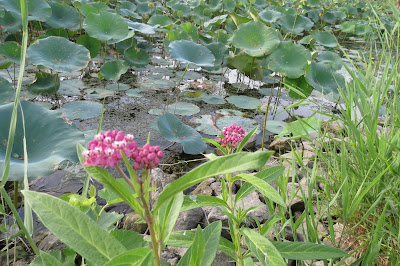Fresh off a natural high from the
Biggest Week in American Birding, here is an effort to encapsulate a week-plus of birding. A special thanks to Rob Ripma and Lester Peyton for allowing me to drive and guide birders on behalf of
B.S.B.O.
 |
Blackburnian Warbler.
Once you have seen this bird, you are hopelessly hooked. |
There are a hundred reasons to love this event! We meet the neatest people and go to the best birding locations. Sure, you may hear how crowded the boardwalk at Magee Marsh is getting, but we take folks away from the boardwalk at Magee. We know twenty other cool places to bird, and many of them have incredible warblers like this Blackburnian warbler! In fact, many of our locations are private areas and you only get in to see them with a Biggest Week Tour.
 |
Bird-in-your-hand birding. Crazy stuff!!!
Photo provided by Julia Plummer. |
Take this location for example:The Arnold property. We had a lovely time birding around the diked wetland, often seeing Wood Ducks and warblers. The Yellows and Common Yellowthroats were everywhere! Can you imaging be tired of warblers?!
Then, in swoops
Scruffy the Black-capped Chickadee. The property owners, Robin and Gena, have the little guy trained to take seeds from hand. Imagine how exited folks from California were to see this! Black-capped Chickadees were a life bird for them one day, and the next day we are posing with a chickadee perched on our hand! Mind. Blown.
 |
| American Redstart at Pipe Creek Wildlife Area |
We visit other locations, which are well-known and well-loved.
Pipe Creek Wildlife Area in Sandusky, Ohio has a long history of providing rarities. The warblers were dripping off the trees the morning we birded at Pipe Creek! Our guide, Tim, also has a knack for working the Soras! Good birding doesn't only happen at Magee.
 |
| The Erie County trip with Tim Jasinski (far right.) |
Meeting people, learning from other guides, enjoying the great outdoors, oh yeah, and birds. Every day was different, every trip was wonderful! And when the birding was slow, patrons were likely to get introduced to some local plants!
 |
New friends from New Mexico:
Roberta Winchester (almost my twin!) and Linda Rockwell. |
Much of the Biggest Week is about seeing friends, old and new. My long time friends Hugh Rose and Judy Kolo-Rose put me up (and put up with me) for the whole week! They should get extra hugs from everyone in the birding community that knows them. They have also been sharing their knowledge and teaching others about birds for many years as well! We birders love to share.
It is also about sharing our love of Ohio's special places with travelers. I couldn't wait to get my friends from New Mexico on some gorgeous birds at
Sheldon Marsh State Nature Preserve in Huron, Ohio. One can hardly believe that few minutes after I took this shot, it started to snow in mid-May! Agh, Mother Nature, give us a break.
 |
| Red-headed Woodpecker |
It is not all about warblers. This Red-headed Woodpecker (a non-migrant) made a huge impression as well. Even common-to-us birds, like Blue Jays are often a life bird to the visitors from the west coast. All of these birds are exciting and a part of our bigger ecosystem
Whether you are a new birder or some jaded, old life-lister, the Biggest Week had something for everybody: Curlew Sandpiper, Whip-poor-wil in your face, Kirtland's Warbler!
The Biggest Week in American Birding: Come for the birds, stay for the love.
Hi-diddle-dee-dee. It is a birder's life for me!























































